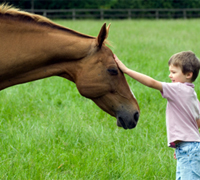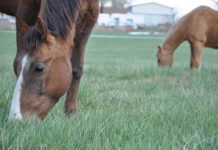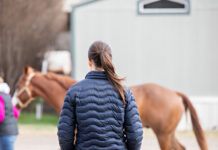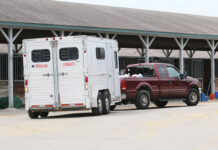 You’ve loved horses for most of your life, but have you passed on this passion to your child? As a parent, it’s a great feeling to discover that your son or daughter shares your interest in horses and riding. But when should you start thinking about buying your kid a horse or pony?
You’ve loved horses for most of your life, but have you passed on this passion to your child? As a parent, it’s a great feeling to discover that your son or daughter shares your interest in horses and riding. But when should you start thinking about buying your kid a horse or pony?
If your child is not old enough to catch, lead, tack up and ride a horse or pony by herself, you should probably wait until she’s older before you think about signing her up for lessons or buying her a mount. A child should be coordinated enough to steer and stop a pony, and she has to be able to follow instructions from a trainer and quickly obey them before she’s put in any sort of dangerous situation. Ponies may be cute, but they can also be naughty. There’s really no such thing as a bombproof horse. Even the calmest of horses and ponies can spook or bolt when startled.
Most reputable lesson barns require that children be around 6 or 7 years old before they start taking lessons because this is usually when they are physically and mentally ready to ride a quiet horse or pony.
Lessons First
If your child shows an interest in horses, don’t rush out to buy the first pony you find on Craigslist, as this scenario is sure to end in tears. Many good ponies aren’t even advertised because they tend to be snapped up quickly by someone who knows the seller.
It’s best to sign up your young rider for lessons at a local lesson barn first and wait to buy a horse or pony until she’s been riding there for at least a year.
If your friends have young riders who do the same type of riding that your child wants to do, ask if they can recommend a good barn. If the same barn is mentioned a few times, check it out. Chat with the trainer to find out if her lesson program will be appropriate for your child.
Your child should start with at least one private lesson so the trainer knows which group lesson will suit her. Group lessons tend to be cheaper than private lessons, and your child will probably enjoy them more. Start with one lesson per week and increase the number if your child is keen to ride more, and if you have the money to support her new horsey hobby. Make sure you pick a barn that has lots of kids in your child’s age group. Half the fun of riding at a lesson barn is making horsey friends.
You should know fairly quickly if your child is going to stick with riding. Horse-crazy kids live, breathe and talk about horses incessantly. They want to ride all the time. If you have to drag your child to the barn, it might be time to switch to another sport—and playing soccer is a lot cheaper than riding!
Outfitting Your Kid for Lessons
It’s a good idea to invest in some basic riding apparel before your child’s first lesson. She’ll be safer in the saddle if she’s sporting the correct gear. Whether she’s going to ride English or western, purchasing an ASTM/SEI-approved safety helmet is a must. It’s important to make sure the helmet fits properly. Local tack stores and major equestrian retailers have knowledgeable staff that can help you.
If she’s going to ride English, invest in jodhpurs, breeches or riding tights, gloves, and short lace-up or zippered paddock boots. If you suspect your child will continue riding, a pair of leather half-chaps will protect her legs from chafing.
If your child wants to ride western, buy her a pair of jeans that will be comfortable in the saddle and low-heeled boots.
Riding Camp
If after a few months it looks like your child is going to continue riding, it’s a great idea to sign her up for camp. Some lesson barns hold their own day camps during the summer. You drop your child off in the morning and she spends all day riding, caring for and learning about horses. If she’s crazy about horses, she will be in heaven.
If she’s mature enough to handle being away from home, consider sending her to an overnight camp. There are hundreds of camps in North America that offer equestrian activities, so do some research before you book a bunk. Make sure the camp offers the type of riding your child likes and find out how much time she’ll spend in the saddle each day. Ask if the camp offers other fun activities, like swimming, drama, and arts and crafts. Some camps hold horse shows during sessions, so your child might have the chance to win a ribbon or two.
To see what kind of camps are available, look for camp advertisements in magazines like Young Rider or Horse Illustrated, and check out online sites like www.kidscamps.com and www.acacamps.org.
Ready to Buy
If your child has been riding regularly for a year or so and shows no signs of losing interest in the sport, now is the time to start looking for a horse or pony. But before you start trolling horse-sale websites, you need to talk to your child’s trainer. Does she think your young rider is ready for the responsibility of looking after a horse? She might suggest that you lease one of her ponies for a while.
Leasing a horse is a way to try out ownership without actually buying the horse. It’s like renting: You agree to look after the horse for a set period of time, but the horse still belongs to the owner. You will probably be responsible for paying a portion—or all—of his feed, board and shoeing, and possibly vet fees, too.
Your child’s trainer may even have a lesson pony you can lease or part-lease, and he’ll probably come with his own tack.
If you decide that your family is ready to take the plunge and buy a horse, you have some tough questions to ask yourself. Can you afford the purchase price of a horse? Can you afford to care for a horse properly? If you board him, you’ll have monthly fees to pay. If you keep him on your own property, you’ll still have feed bills to pay on a regular basis. If the horse gets sick or injured, do you have the money to pay the veterinarian? And regular hoof care is essential—you’ll be adding the farrier to your payroll every six weeks or so. The list goes on, especially if your child plans to show or quickly outgrows her clothing.
If you have the finances to support your child’s new mount, then the horse search can begin.
Where to Start
Before you begin your search, have a good idea about what you’re looking for so you don’t waste time and gas looking at unsuitable mounts. The best first horse is one that has some mileage on him, preferably a teenager or senior citizen that will be calm and patient with your child. An older horse that has been well-trained will give your child lots of confidence. Don’t buy a young horse and think that your child will “learn with him”; a green horse is never a good match for an inexperienced child.
Look for a horse that has been ridden by kids in the past. Pony Club and 4-H stars are often passed down to younger program participants. They are usually on the market for only a very short time.
You want a horse that is good-tempered and friendly to children, not a grump that pins his ears back, kicks out or runs away every time your child approaches him.
It’s also important to consider the size of your child’s future mount before you begin your hunt. How big is your child? If she’s tiny, she could ride a pony for a few years. But remember, ponies aren’t always the best-behaved creatures. And if a tiny pony becomes unruly, it’s hard for an adult to hop on and school him. If you are a capable rider, consider buying a pony that is big enough for you to school occasionally. He may need it!
If your child is growing like a weed, consider buying her a small horse. Just make sure that whatever mount you buy isn’t so big or strong that your child can’t control him. Her lower legs must reach at least halfway down his sides.
Also, your life will be easier if your child is able to tack up her horse by herself. If she can’t get the bridle over his ears or the saddle on his back, he’s probably a bit big for her.
One thing you shouldn’t worry about too much is the color of the horse. Your child might dream of buying a pretty palomino, but there may be a plain bay horse that suits her better. If a horse is well-behaved and your child gets along with him, his color really isn’t important. The same generally goes for the gender of the horse; it doesn’t have to be a gelding. Some mares can be a bit moody and sensitive when they are in season, but this behavior only lasts a few days. Most mares in season do their jobs without a fuss. However, a stallion is never a good match for a child.
Finally, you must consider the price. How much are you willing to spend on the horse that will be responsible for your child’s safety? An experienced mount is going to cost more than an untrained one. However, the cheaper, untrained horse will cost you more in the long run if he needs professional training to become a safe riding horse. There are bargains out there, but you may have to look far and wide for them—and sometimes you just get lucky and stumble across a gem. Your child’s trainer should be able to give you a good idea about how much you should expect to pay for a kid’s mount in your area.
Where to Look
Looking for a child’s horse isn’t that different from searching for a horse for an adult, so make sure you read “Shop Right” on page 26. This handy guide will help you avoid the pitfalls of buying an unsuitable horse or pony.
Most good children’s horses and ponies are sold through word-of-mouth. The first person you should talk to is your child’s trainer. Does she know of any suitable mounts that are for sale? Let her know you’re looking and involve her in the search. She probably has lots of contacts. You may have to pay her a finder’s fee, but it will be worth it if she finds you a good-mannered, safe pony. She may even have a pony for sale in her barn that would suit your child.
Talk to other horsey parents and ask them to spread the word about your search. If your child is in 4-H or Pony Club, let the leaders of the club know that you’re looking for a quiet child’s mount.
If you do resort to looking at ads online or in local horse journals, be aware of “ad talk.” Remember, no one is going to say “I want to sell a badly behaved horse that bites kids” in an advertisement. Look for wording like “ideal first horse,” “Pony Club/4-H pony,” “good all-rounder,” “quiet to handle,” and “easy to clip, shoe and catch.”
Avoid ads that say things like “not a novice ride” or “green.” And don’t get excited by terms like “potential hunter over fences star.” This just means the horse is inexperienced and he’ll need to be trained.
One place you shouldn’t look for a horse or pony is an auction. It might seem tempting to buy a horse this way because there can be bargain prices. But you’ll know nothing about the horse you’re looking at, and your child won’t be able to try him out properly. Some auctions are also notorious dumping grounds for lame, ill or badly behaved horses. Unless you’re an experienced horse person who can spot a diamond in the rough, steer clear of auctions.
Start Your Search
If you follow most of the advice in this article, you should be well-prepared to start your search for your child’s first mount. You won’t make the mistakes that many parents make when buying a first horse. For example, surprising a child with a pony on her birthday or Christmas is a really bad idea, although plenty of parents do it. Never buy a pony without letting your kid ride him first. She doesn’t have to know that he’s going to be for her; just tell her that her trainer needs her to test him out for another pupil.
Shopping for a child’s horse can be risky, but if you’re cautious, use common sense and are realistic about your child’s riding abilities, you should be ready to start the big search. A suitable horse or pony is out there somewhere, just waiting to join your family!
Further Reading
Lesley Ward is the editor of Young Rider magazine and the author of Jumping for Kids (Storey Books).
This article originally appeared in the 2012 issue of Horses USA.






